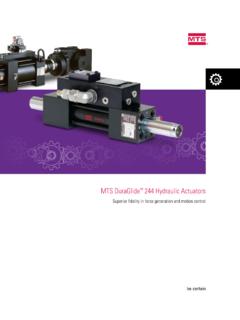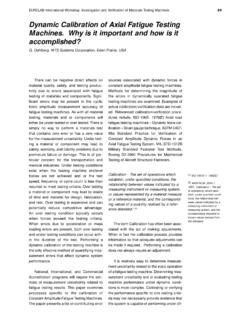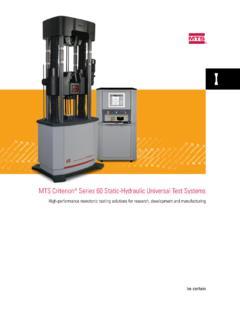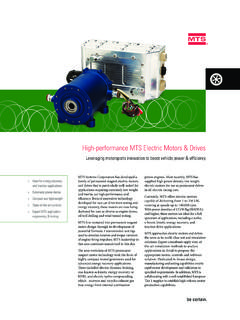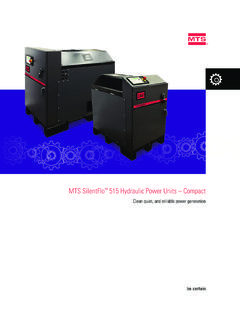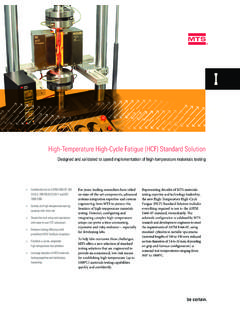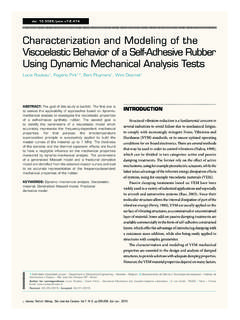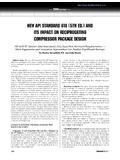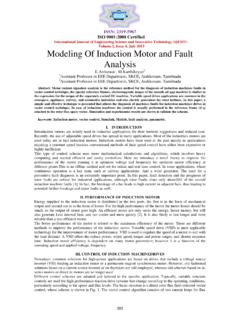Transcription of High-Force Dynamic Mechanical Analysis (DMA) - …
1 High-Force Dynamic Mechanical Analysis (DMA) Dynamic characterization of viscoelastic materials be THE WIDEST RANGE OF force AND FREQUENCY MEASUREMENT CAPABILITIES, MTS IS A LEADING PROVIDER OF Mechanical TEST SOLUTIONS FOR THE Dynamic CHARACTERIZATION OF VISCOELASTIC MATERIALS AND COMPONENTS. COMPLEMENTING THIS BROAD SYSTEM PORTFOLIO IS APPLICATION SOFTWARE FOR DMA, FATIGUE AND OTHER Dynamic AND STATIC TEST to DMA In performance-critical applications, researchers and product developers depend on accurate Dynamic materials characterization. Elastomers, thermoplastics and thermosets all require Dynamic characterization to evaluate behavior before these materials are used to improve cars, planes, medical devices and consumer Mechanical Analysis , or DMA, is a Dynamic characterization technique that measures stress as a function of strain, or force as a function of displacement.
2 Viscoelastic materials, like polymers, behave both like an elastic solid and a viscous fluid. DMA measures the viscoelastic properties under Dynamic oscillatory (often sinusoidal) test conditions. When Dynamic stress is applied to the material and a resultant strain is measured: The phase difference, , between the stress and strain waves is measured The phase lag will be 0 for purely elastic materials and 90 for purely viscous materials Viscoelastic materials will exhibit an intermediate phase differenceViscoelastic Stress & Strain Loss Modulus (E ) measures the energy dissipated as heat, representing the viscous portion Storage Modulus (E ) measures the stored energy, representing the elastic portion Tan Delta (Tan ) is simply a ratio between the two, loss/storage, or E /E Typical viscoelastic properties include the following parameters.
3 (E ) The storage modulus is the elastic component and describes the sample s stiffness (E ) The loss modulus is the viscous component and is related to the sample s ability to dissipate Mechanical energy through molecular motion (Tan ) The tangent of phase difference provides information on the relationship between the elastic and inelastic components (E*) The complex modulus equals stress divided by strain When the complex modulus (E*) and the measurement of are known, the storage modulus, (E ), and loss modulus (E ), can be calculated. Ta n Tan DeltaStorage modulus, MPaE (loss modulus)E (storage modulus)Temperature, C Loss modulus, MPa104103102101-100 -50 0 50 100 150 : 0 < < / 2 MTS Dynamic Characterization ExperienceWith core competencies in force control and motion measurement, MTS is ideally suited to developing new solutions for accurate and repeatable Dynamic materials characterization.
4 The materials testing division originated more than fifty years ago with a focus on durability testing to meet the needs of the aerospace industry. During this time, MTS pioneered closed-loop control solutions for testing applications, and soon developed into a test and measurement leader. Today, with opportunities to solve testing challenges in a wide range of industries across the globe, MTS continues to create better solutions for materials testing. MTS has a long history of developing solutions for viscoelastic characterization, especially through working with the automotive industry to improve elastomer testing. This collaboration has led to many innovations and the discovery of best practices for testing viscoelastic materials. As a result of these decades of Dynamic characterization experience, MTS can offer an extensive product family that encompasses a wide range of forces and frequencies; comprehensive characterization expertise for materials and components; and software packages to address DMA, fatigue & fracture, durability, tension/compression, flex/bend, static deflection, and additional templates to address specific standards, including FDA regulatory tests for biomaterials and medical Mechanical ResonancesHigh-frequency excitation can inadvertently produce Mechanical resonant modes within the load frame structure which will often corrupt the measurement accuracy of displacement and force transducers.
5 Displacement transducer measurements (either LVDT or Encoder) can be corrupted by erroneous motion at the transducer s mounting base due to resonant transducer measurements can be corrupted by resonant vibrations that induce high acceleration on the transducer. This acceleration can result in significant inertial errors in the force measurement. A good DMA system will not exhibit any detrimental Mechanical resonant modes in the axis of Across Extreme Dynamic Range Amplitudes For elastomer and thermoplastic materials, measurements are often required both above and below the glass transition temperature within the same test set-up. The material elastic modulus (and stiffness) can change by a factor of 1,000 when transitioning from temperatures below the glass transition in which the material is hard like glass, to temperatures above the glass transition temperature at which the material is rubbery and relatively soft.
6 This implies that if a constant sinusoidal force were applied throughout the test, the material displacements in the glassy region could be relatively small. But that same sinusoidal force amplitude applied above the glass transition could result in displacements changing by a factor of 1000. Conversely if a constant sinusoidal displacement were applied throughout the test, the material forces in the rubbery region could be relatively small. But that constant displacement amplitude applied above the glass transition could result in forces changing by a factor of 1000. Both scenarios require a test system with the ability to measure across extreme Dynamic range Amplitude Control Most elastomers and thermoplastics have a significant amplitude non-linearity, meaning that the measured elastic modulus (or stiffness) of the material is dependent on the amplitude of the applied excitation.
7 Since the material modulus and response are so amplitude dependent, it is extremely critical that the test input excitation amplitude is known and controlled accurately. This amplitude control becomes even more difficult at higher test frequencies. When choosing a test system for conducting DMA, it is critical to have a machine that does not introduce Mechanical resonances, can measure across a great range of amplitudes and provides superior Dynamic Elements for Accurate DMA Test SystemsLow bandwidth control loops or sluggish outer loop compensators can impose additional cycles on the specimen and cause internal specimen heating, resulting in misleading material characteristic data. Lack of extremely stable control laws can also result in control loop instability which can damage the specimen.
8 Therefore accurate Dynamic control is a critical DMA test system attribute. E , E (N/mm 2)25002000150010005000-70 -60 -50 -40 -30 -20 -10 0 Tan DeltaTemperature ( C)E (N/mm 2)E (N/mm 2)Tan (unitless) (mm, )Standard Performance Curve for MTS Acumen 1 Frequency (Hz)1 10 Unloaded Amplitude: +/ N Maximum Loaded Amplitude: +/ 1080 NStandard Performance Curve for MTS Acumen 3 Displacement (mm ) (Hz)1 10 100 Maximum Unloaded Amplitude: +/ N Maximum Loaded Amplitude: +/ 2475 NMTS Acumen Solution for High-Force DMADMA testing requires control of force and displacement, and accurate measurement in order to calculate Dynamic stiffness.
9 In a typical DMA profile, one controls both a mean load or displacement and a Dynamic load or displacement. If the signals include extraneous resonances, the Dynamic stiffness will not be accurate. Superior AccuracyThe MTS Acumen Electrodynamic Test System provides a singular solution for DMA and fatigue testing in a quiet, energy efficient package. The electrodynamic load frame design also eliminates detrimental Mechanical resonances, providing additional accuracy specifically for DMA CompensationExceptional compensation of accelerating load train components is especially important in DMA due to high test frequencies and their impact on calculated material properties. MTS uses a patent-pending acceleration compensation technique that results in more accurate correction.
10 high -fidelity sensors provide compensation for very small inertial errors, which results in the ability to collect accurate DMA data at significantly lower force Resolution DisplacementThe MTS Acumen digital encoder provides higher resolution than an analog sensor, and can be used for testing peak to peak displacement as low as eight microns ( mm) for higher repeatability and performance control. This capability is crucial for DMA measurement on stiff samples with small Testing OptionThis high -performance sensor package provides force measurement for Dynamic loads as low as N peak to peak (standard system sensors test as low as 5 or 10 N peak to peak). The low- force option includes an Advanced Dynamic Response (ADR) sensor that is mounted on the system load cell and measures the Dynamic loading while the system load cell measures the mean load.
